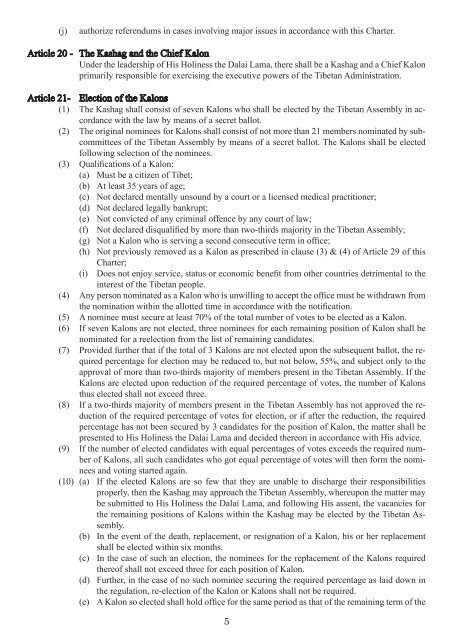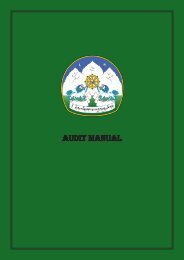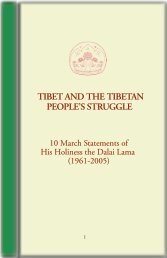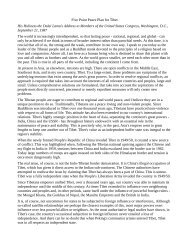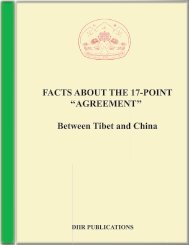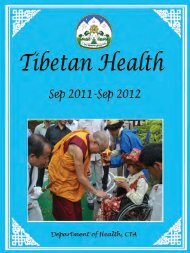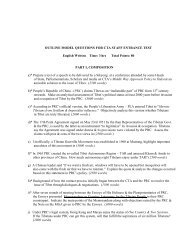CHARTER OF THE TIBETANS-IN-EXILE
CHARTER OF THE TIBETANS-IN-EXILE
CHARTER OF THE TIBETANS-IN-EXILE
Create successful ePaper yourself
Turn your PDF publications into a flip-book with our unique Google optimized e-Paper software.
(j)authorize referendums in cases involving major issues in accordance with this Charter.Article 20 - The Kashag and the Chief KalonUnder the leadership of His Holiness the Dalai Lama, there shall be a Kashag and a Chief Kalonprimarily responsible for exercising the executive powers of the Tibetan Administration.Article 21- Election of the Kalons(1) The Kashag shall consist of seven Kalons who shall be elected by the Tibetan Assembly in accordancewith the law by means of a secret ballot.(2) The original nominees for Kalons shall consist of not more than 21 members nominated by subcommitteesof the Tibetan Assembly by means of a secret ballot. The Kalons shall be electedfollowing selection of the nominees.(3) Qualifications of a Kalon:(a) Must be a citizen of Tibet;(b) At least 35 years of age;(c) Not declared mentally unsound by a court or a licensed medical practitioner;(d) Not declared legally bankrupt;(e) Not convicted of any criminal offence by any court of law;(f) Not declared disqualified by more than two-thirds majority in the Tibetan Assembly;(g) Not a Kalon who is serving a second consecutive term in office;(h) Not previously removed as a Kalon as prescribed in clause (3) & (4) of Article 29 of thisCharter;(i) Does not enjoy service, status or economic benefit from other countries detrimental to theinterest of the Tibetan people.(4) Any person nominated as a Kalon who is unwilling to accept the office must be withdrawn fromthe nomination within the allotted time in accordance with the notification.(5) A nominee must secure at least 70% of the total number of votes to be elected as a Kalon.(6) If seven Kalons are not elected, three nominees for each remaining position of Kalon shall benominated for a reelection from the list of remaining candidates.(7) Provided further that if the total of 3 Kalons are not elected upon the subsequent ballot, the requiredpercentage for election may be reduced to, but not below, 55%, and subject only to theapproval of more than two-thirds majority of members present in the Tibetan Assembly. If theKalons are elected upon reduction of the required percentage of votes, the number of Kalonsthus elected shall not exceed three.(8) If a two-thirds majority of members present in the Tibetan Assembly has not approved the reductionof the required percentage of votes for election, or if after the reduction, the requiredpercentage has not been secured by 3 candidates for the position of Kalon, the matter shall bepresented to His Holiness the Dalai Lama and decided thereon in accordance with His advice.(9) If the number of elected candidates with equal percentages of votes exceeds the required numberof Kalons, all such candidates who got equal percentage of votes will then form the nomineesand voting started again.(10) (a) If the elected Kalons are so few that they are unable to discharge their responsibilitiesproperly, then the Kashag may approach the Tibetan Assembly, whereupon the matter maybe submitted to His Holiness the Dalai Lama, and following His assent, the vacancies forthe remaining positions of Kalons within the Kashag may be elected by the Tibetan Assembly.(b) In the event of the death, replacement, or resignation of a Kalon, his or her replacementshall be elected within six months.(c) In the case of such an election, the nominees for the replacement of the Kalons requiredthereof shall not exceed three for each position of Kalon.(d) Further, in the case of no such nominee securing the required percentage as laid down inthe regulation, re-election of the Kalon or Kalons shall not be required.(e) A Kalon so elected shall hold office for the same period as that of the remaining term of the5


